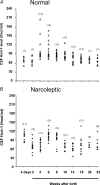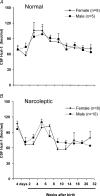Developmental changes in CSF hypocretin-1 (orexin-A) levels in normal and genetically narcoleptic Doberman pinschers
- PMID: 15308685
- PMCID: PMC1665256
- DOI: 10.1113/jphysiol.2004.070573
Developmental changes in CSF hypocretin-1 (orexin-A) levels in normal and genetically narcoleptic Doberman pinschers
Abstract
Loss of hypocretin cells or mutation of hypocretin receptors causes narcolepsy. In canine genetic narcolepsy, produced by a mutation of the Hcrtr2 gene, symptoms develop postnatally with symptom onset at 4 weeks of age and maximal symptom severity by 10-32 weeks of age. Canine narcolepsy can readily be quantified. The large size of the dog cerebrospinal fluid (CSF) cerebellomedullary cistern allows the withdrawal of sufficient volumes of CSF for accurate assay of hypocretin levels, as early as postnatal day 4. We have taken advantage of these features to determine the relation of CSF hypocretin levels to symptom onset and compare hypocretin levels in narcoleptic and normal dogs. We find that by 4 days after birth, Hcrtr2 mutants have significantly higher levels of Hcrt than normal age- and breed-matched dogs. These levels were also significantly higher than those in adult narcoleptic and normal dogs. A reduction followed by an increase in Hcrt levels coincides with symptom onset and increase in the narcoleptics. The Hcrtr2 mutation alters the normal developmental course of hypocretin levels.
Figures




Similar articles
-
Narcolepsy without cataplexy: 2 subtypes based on CSF hypocretin-1/orexin-A findings.Sleep. 2006 Nov;29(11):1439-43. doi: 10.1093/sleep/29.11.1439. Sleep. 2006. PMID: 17162990
-
Role of the hypocretin (orexin) receptor 2 (Hcrt-r2) in the regulation of hypocretin level and cataplexy.J Neurosci. 2011 Apr 27;31(17):6305-10. doi: 10.1523/JNEUROSCI.0365-11.2011. J Neurosci. 2011. PMID: 21525270 Free PMC article.
-
Validation of the ICSD-2 criteria for CSF hypocretin-1 measurements in the diagnosis of narcolepsy in the Danish population.Sleep. 2010 Feb;33(2):169-76. doi: 10.1093/sleep/33.2.169. Sleep. 2010. PMID: 20175400 Free PMC article.
-
Narcolepsy and the hypocretins.Metabolism. 2006 Oct;55(10 Suppl 2):S36-9. doi: 10.1016/j.metabol.2006.07.011. Metabolism. 2006. PMID: 16979425 Review.
-
Symptomatic narcolepsy, cataplexy and hypersomnia, and their implications in the hypothalamic hypocretin/orexin system.Sleep Med Rev. 2005 Aug;9(4):269-310. doi: 10.1016/j.smrv.2005.03.004. Sleep Med Rev. 2005. PMID: 16006155 Review.
Cited by
-
The anatomical, cellular and synaptic basis of motor atonia during rapid eye movement sleep.J Physiol. 2016 Oct 1;594(19):5391-414. doi: 10.1113/JP271324. Epub 2016 Jul 3. J Physiol. 2016. PMID: 27060683 Free PMC article. Review.
-
Man's best friend becomes biology's best in show: genome analyses in the domestic dog.Annu Rev Genet. 2010;44:309-36. doi: 10.1146/annurev-genet-102808-115200. Annu Rev Genet. 2010. PMID: 21047261 Free PMC article. Review.
-
CSF levels of hypocretin-1 (orexin-A) peak during early infancy in humans.Sleep. 2012 Feb 1;35(2):187-91. doi: 10.5665/sleep.1618. Sleep. 2012. PMID: 22294808 Free PMC article.
-
Animal models of narcolepsy.CNS Neurol Disord Drug Targets. 2009 Aug;8(4):296-308. doi: 10.2174/187152709788921717. CNS Neurol Disord Drug Targets. 2009. PMID: 19689311 Free PMC article.
-
Developmental divergence of sleep-wake patterns in orexin knockout and wild-type mice.Eur J Neurosci. 2007 Jan;25(2):512-8. doi: 10.1111/j.1460-9568.2006.05292.x. Eur J Neurosci. 2007. PMID: 17284193 Free PMC article.
References
Publication types
MeSH terms
Substances
Grants and funding
LinkOut - more resources
Full Text Sources
Medical

